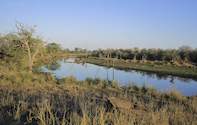
Reports and estimates of the impact of climate change appear almost daily, but those by the Intergovernmental Panel for Climate Change remain the authoritative voice.
The World Economic and Social Survey (WESS), published annually by the UN Department for Economic and Social Affairs, has devoted its 2009 issue to climate change. It includes an accessible, if unsettling, guide to some of the major impacts of climate change in various African countries, based on the IPCC's reports. Here is a quick tour of the guide.
Food security
Northern Africa from Morocco to Egypt
By 2100, losses in agricultural production might amount to between 0.4 percent and 1.3 percent of gross domestic product (GDP).
Egypt: By 2050, rising temperatures could shrink production of many crops, ranging from 11 percent for rice to 28 percent for soybeans. A projected decline in precipitation will also affect the flow of the Nile River, while a rise in sea level will affect food production in the Nile Delta.
West Africa
By 2100, agricultural losses might represent two percent to four percent of GDP. Rising annual global temperature, causing warmer seas, will affect fisheries in northwestern Africa.
Gulf of Guinea: Lagoon fisheries and aquaculture could be hit when the low-barrier beaches that limit coastal lagoons are destroyed by the rising sea level. A change in rainfall could also affect the quantity of water in the rivers that feed the lagoons.
Guinea: Between 17 percent and 30 percent of the existing rice-field area could be lost to permanent flooding by 2050.
Benin and Cote d'Ivoire: The inundation and subsequent salinization of coastal soil could threaten palm oil and coconut production.
East Africa
Rainfall is expected to increase in some parts of the region. The loss of about 20 percent of plant and animal life in Lake Tanganyika is projected, with a 30 percent decrease in fish yields.
In Kenya a one-metre rise in the sea level could affect the production of mangoes, cashew nuts and coconuts, causing losses of almost US$500 million a year.
On the plus side, in parts of the Ethiopian highlands a combination of higher temperatures and better rainfall may lengthen the growing season.
Southern Africa
More frequent El Niño conditions - in which sea surface temperatures become warmer across the central and eastern Pacific Ocean - could disrupt rains, bringing a notable drop in maize production.
On the other hand, growing seasons may lengthen in parts of Southern Africa, for example Mozambique, owing to a combination of increased temperature and higher rainfall.
South Africa: In Africa's major grain producer net revenues from crops could shrink by up to 90 percent by 2100.
Water resources
Northern Africa
More people could be experiencing water stress by 2055, particularly in Egypt, where a rapidly expanding population - expected to reach between 115 and 179 million by 2050 - might be demanding more water as the climate gets hotter.
East and West Africa
Rainfall is likely to increase in these regions, easing droughts in the east of the continent but bringing more frequent floods in the west.
Southern Africa
Large areas of the region are already experiencing water shortages, or are arid and trying to prevent encroaching desertification, so there is likely to be a greater number of people living with water stress by 2055 as rainfall becomes more erratic or declines.
Health
West Africa
Good news! By 2050 and beyond, a large part of the western Sahel will probably become unsuitable for malaria transmission.
East Africa
Based on parasite survey data, the previously malaria-free highland areas of Ethiopia, Kenya, Rwanda and Burundi could experience modest incursions of malaria by the 2050s, with conditions for transmission becoming highly suitable by 2080s. In central Somalia, areas that now have low rates of malaria could develop high prevalence of the disease. Rift Valley fever epidemics - evident during the 1997-1998 El Niño event in East Africa and associated with flooding - could become more frequent and widespread as El Niño events increase.
Southern Africa
More areas are likely to become more suitable for malaria, with a southward expansion of the transmission zone into Zimbabwe and South Africa. Parts of the Angolan highlands where there are low rates of malaria transmission could see the disease become rife by the 2080s.
© IRIN. All rights reserved. photo: Lynette Strauss

